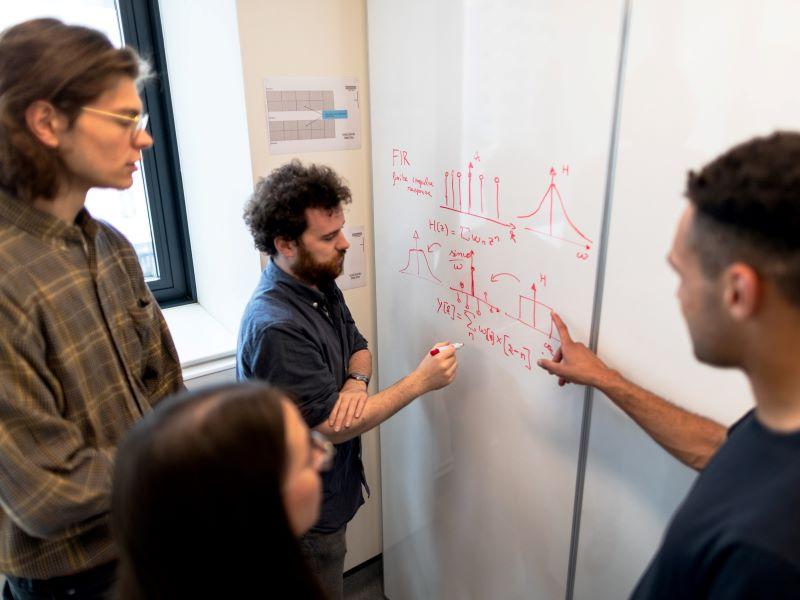A regular feature of academic life, and perhaps a reflection of elements of US individualism, is a stress on “single-authored” pieces. This emphasis tends to begin well before students find themselves in our classrooms, but we quite often reinforce this individualist notion – as if ideas are the creations – or property – of singular Great Minds rather than the product of cooperation, collaboration and larger social relationships.
I regularly assign a final paper rather than a final exam for my courses. Many professors choose this option, particularly when developing and improving critical thinking skills are central learning objectives. Students write their own final papers, but I hope to contribute some lessons on the pitfalls of notions of “single authors” in the context of their assignments.
- Collaborative learning in the digital space
- How to foster collaboration among students trained to compete
- Supporting collaborative learning among remote students through peer review
In some classes, I allow students to choose their own final paper topic, as long as it is developed through the lens of the course subject or theme, and in other classes I opt to give students several prompts to choose from. Either way, many students have confessed that they feel a need to “gatekeep” their final paper ideas and are reluctant to discuss ideas with their classmates for fear of someone else “taking” “their” idea.
To address this issue, I have begun to integrate collaborative assignments where students help each other develop a final paper topic and then continue to help each other edit their rough drafts and improve their papers before submission. Here, I explain how I frame assignment activities to help students learn that, ultimately, all writing is collaborative, and to demonstrate how powerful a discussion with a colleague can be in terms of developing ideas for a project. Relatedly, enterprising students might note the benefits of cooperation, solidarity and mutual aid.
I will outline three collaborative steps in developing assignments – picking a paper topic, collaborative peer editing and paper presentations. Attached above is a document providing an example timeline for how to implement these assignments:
Picking a paper topic
I have found that allowing students to formulate their own paper topic, or pick from a handful of prompts, works best. Students are paired up and given instructions on how to help each other formulate a paper topic or choose from a selection of prompts.
If creating their own paper topic, students must discuss with their partner how the topic is related to course concepts and materials, and partners are encouraged to push each other to justify how a paper on Star Wars, for example, could be analysed through the scope of their specific course.
Once students have chosen their paper topic, they are paired with students who are writing on similar topics so they can share their worries and their enthusiasm for the assignment and how to approach it successfully.
Collaborative peer editing
Students work on a rough draft after clearing their paper topic with their partner and the professor.
An entire class period is devoted to editing each other’s papers, with clear prompts provided so students can learn how to constructively critique a paper. Example prompts for peer reviewers might include the following:
- How do you plan to adhere to the final paper guidelines? Go over all paper guidelines and talk with your partner in detail about how to fully adhere to them.
- How are you introducing the larger context and then situating your focus within it? Make sure your partner directly connects their paper topic to relevant course content in the first paragraph. From there, they need to narrow their focus.
- Are your arguments/points clear? What needs to be clarified? Make sure your partner is explaining all terms and concepts for an everyday audience to understand.
- Have you used appropriate in-text citations? Did you (or do you plan to) format your bibliography correctly? Go over this part of the assignment carefully with your partner.
- Indicate which parts of the paper you find most or least effective, and why, and suggest how to improve those sections. Take the time to give meaningful advice to help your partner improve their final paper.
Before peer editing begins, it’s important for the professor to take some time to explain both how and why to constructively critique a peer, as well as how and why to be open to constructive critique.
Before introducing the above prompts, it is worth explaining how reviewing in academia is a norm. I often cite how I have paid scholars quite a bit of money to do the same for my professional writing, and remind the students that they are extremely lucky to have access to an editor-of-sorts for this project.
I ask students to raise their hands if they’ve ever submitted a paper, and then a day or so later found mistakes they wish they had caught before turning it in, or sentences they could have structured better. Typically, all students raise their hands, which leads to a discussion of how any paper, from undergrad assignments to top journal articles, can be improved. I explain how this exercise helps students find ways to improve both form and content for their papers so they can catch those opportunities before submitting.
Professors should make it clear that the reviewer’s comments are meant to be constructive and that both reviewer and writer need to make sure advice is given and received in a gracious manner. Remind students that in this process, we’re discussing ideas and their worth, not the worth of the authors. Learning how to receive and give constructive criticism, and not take it as a personal attack, will serve students in their studies and careers.
Paper presentations
On the final day of the semester, each student has roughly five minutes to verbally present their paper topic to the class – the point of this exercise is for students to learn how to briefly explain both the interest and importance of their paper topics to the class, with allotted time for suggestions and comments for each student.
After presenting, each student receives one comment on how to improve their final paper and one comment on what they did well – this will take about two minutes for each student after they present. Professors can assign each student a “team” to provide those comments on presentation day or rely on audience participation, depending on the nature of the class.
Students use exercise this as an opportunity to gather feedback to help enhance and finalise their papers before submission.
While the final assignment for these classes is the paper, I scaffold students’ work with these collective processes to illuminate how knowledge is produced socially – these invisible lessons tend to make for better papers, reflexive learners and students who recognise the social nature of knowledge and can unpack the illusion of the “single author”.
Abbey S. Willis is a teaching assistant professor of sociology at Siena College.




comment